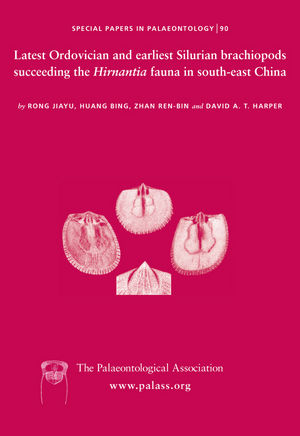Reg. Charity No. 1168330

Late Hirnantian and early Rhuddanian shelly faunas dominated by brachiopods are well developed in the clastic facies succeeding the cool and deep-water, very-lowdiversity Hirnantia fauna in Zhejiang and Jiangxi provinces, south-east China; elsewhere in the world, during this interval, brachiopod assemblages are generally rare. The Cathaysiorthis brachiopod fauna, occurring within the Normalograptus persculptus to Akidograptus ascensus biozones, straddling the Ordovician and Silurian boundary, is systematically described herein. Comparison of the fauna with the preceding Hirnantia fauna in South China shows some major contrasts, but similarities in the dominance of orthides and strophomenides, the rarity of pentamerides and atrypides, and the lack of trimerellides. Virtually all the genera recorded are ‘hold-over’ genera from the diverse latest Katian fauna and have long ranges and wide geographical distributions except for some endemics. A major faunal change in the brachiopod fauna occurred within the N. persculptus Biozone, beneath the Ordovician–Silurian boundary. The end of the second episode of the Ordovician extinction event of brachiopods may have extended from the middle N. persculptus Biozone, prior to the start of the Silurian, coincident with N. persculptus Biozone – bearing beds generally overlying the Hirnantia fauna and a striking positive carbonate isotope excursion, present in many places in the world. The end Ordovician extinction is substantially different from the end Permian mass extinctions characterized by a sharp decline at all taxonomic levels with high extinction rates, the absence of ‘hold-overs’, Lazarus and progenitor taxa, prevalent miniaturization of shell size and a much slower recovery rate during the Triassic. This sharp contrast was enhanced by the relative intensity of both extinctions with widely different causes, patterns and consequences and by the relatively weak ecosystem disturbances through the Ordovician–Silurian transition rather than the ecosystem collapse during the early Triassic. A new family, Cathaysiorthidae, and five new genera or subgenera, Aegiromena (Aegiromenella), Eopholidostrophia (Megapholidostrophia), Chunanella, Yuhangella and Eospirifer (Protospirifer), are established, as well as fourteen new species: Anisopleurella asiatica, Chunanella chunanensis, Deliella delicatula, Dolerorthis (D.) multicostellata, Epitomyonia subquadrata, Eopholidostrophia (Megapholidostrophia) magnifica, Eoplectodonta (E.) boucoti, Eospirifer (E.) eosinensis, Fardenia (F.) flexa, Hesperorthis orientalis, Katastrophomena zheganensis, Mendacella mutabilis, Sulcatospira simplex and Yuhangella yui.